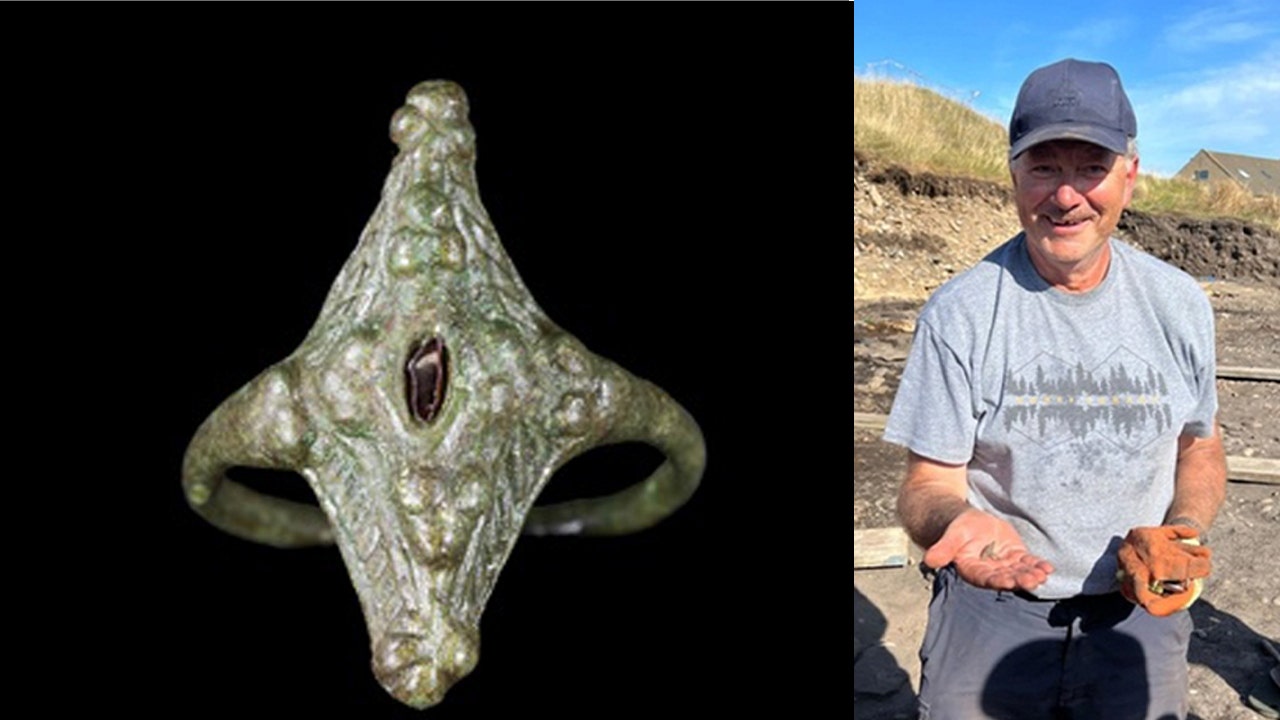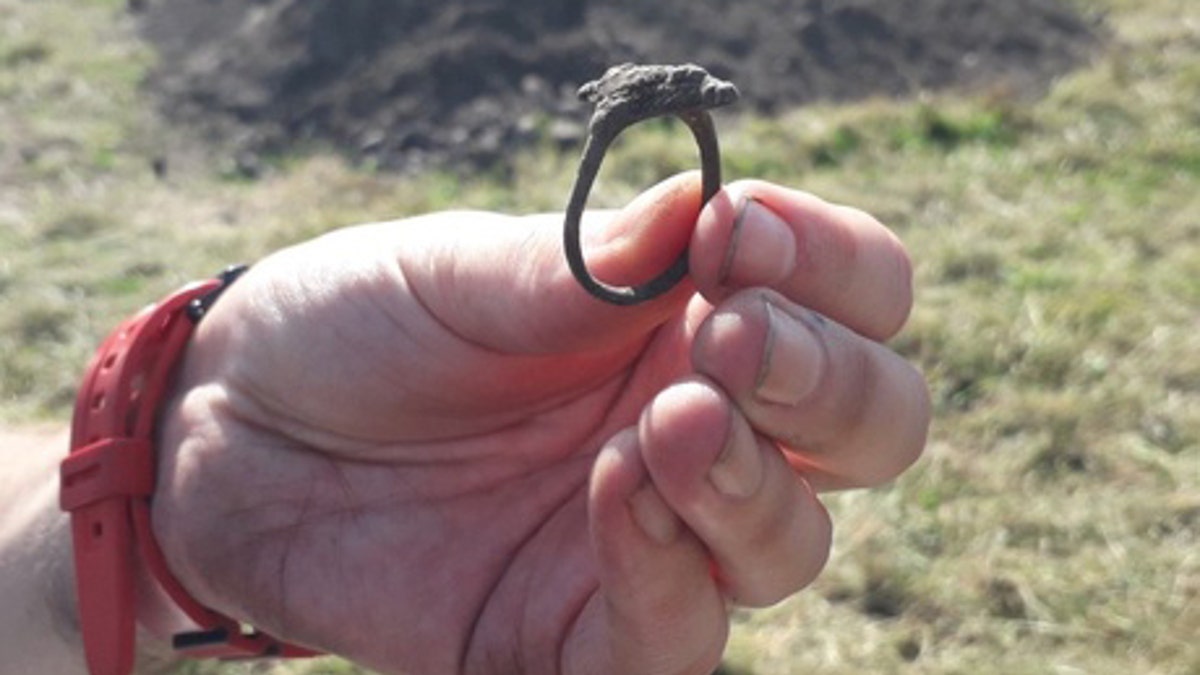World
Volunteer during archaeological excavation finds 'remarkable' piece of jewelry in Scotland

During a dig at Burghead fort in Scotland, a volunteer spent weeks digging with no finds. That all changed after 30 days of searching when John Ralph discovered a Pictish ring at the site.
“The dig was my fifth dig of the season. I had dug for more than 30 days and had found very little of interest,” Ralph told Fox News Digital in an email. When he finally found something, Ralph described his emotions as a mix of “relief, disbelief and happiness.”
“Once I found out what I had found, I felt lucky and privileged to have found something so important,” Ralph said.
Volunteer John Ralph came across a rare find during a Scotland dig. (University of Aberdeen)
MOM, SON DIG UP ANCIENT OBJECT OFTEN FOUND NEAR BURIAL GROUNDS WHILE GARDENING
Ralph’s find turned out to be an ancient Pictish ring that had been at the site, untouched, for more than a thousand years, according to a Sept. 4 news release from the University of Aberdeen. The ring takes a shape similar to that of a kite with a red-colored detail at its center.
Picts were ancient people who lived in what is now eastern and northeastern Scotland, according to Britannica. Much of their history is unknown with little evidence left behind about their presence, according to the University of Aberdeen.
Professor Gordon Noble has led excavations of Burghead over the last three years. Ralph, a former engineer and graduate of the University of Aberdeen, became a volunteer at one of the digs after seeing a post on Facebook seeking out individuals to assist.
“I always had an interest in archaeology and having recently retired and coming out of COVID, I was looking for something interesting to do,” Ralph said. “I saw a call on Facebook for volunteers for the dig at Burghead, and since it was the town I was raised in and my sister stays there, I just thought, ‘Why not?’”

Ralph’s discovery turned out to be an ancient Pictish ring. (University of Aberdeen)
VALUE OF ANCIENT STONE UNEARTHED IN GARDEN BY GEOGRAPHY TEACHER RECENTLY REVEALED
Noble considered Ralph’s find “truly remarkable,” per the news release.
“There are very few Pictish rings which have ever been discovered and those we do know about usually come from hoards which were placed in the ground deliberately for safekeeping in some way,” Noble said, per the press release. “We certainly weren’t expecting to find something like this lying around the floor of what was once a house but that had appeared of low significance so, in typical fashion, we had left work on it until the final day of the dig.”
Now, the ring is in the custody of the National Museum of Scotland’s Post-excavation Service, where research is being done to learn more about the ancient find.
“We will now look at the ring, evidence of buildings and other artifacts to consider whether the ring was crafted on the site and who such an important piece of jewelry might have been made for,” Noble said, according to the press release.

There are still many unanswered questions about the find. Further research is being conducted to find out more about the discovery. (University of Aberdeen)
As for Ralph, he has learned a lot from his time volunteering at archaeological digs, including the challenging physical work that leads to making these discoveries, which isn’t always as easy as it may be portrayed.
“Pictures of archaeologists gently trowelling at the ground can give an impression of easy work, but in truth some aspects of a dig are like extreme gardening and can be physically demanding,” Ralph told Fox News Digital. “You are also required to be vigilant for changes of ground patterns, features and artifacts; so a good workout physically and mentally.”

World
Bridgerton Casts Halo Star as Benedict’s Season 4 Love Interest — Watch New Teaser

ad
World
Is Iran supplying ballistic missiles to Russia for the Ukraine war?

Tehran, Iran – Ukraine’s Western allies claim Iran has sent short-range ballistic missiles to Russia in a major escalation – a claim Tehran has rejected as “completely baseless and false” and pointed to what it sees as Western hypocrisy.
The United States, Britain, France and Germany on Tuesday imposed more sanctions on Iran for what they called Tehran’s “escalatory” decision. They provided no evidence and the weapon has not been observed in the battlefield yet.
Tehran has described the latest sanctions on Iranian firms and individuals as “economic terrorism”.
The Kremlin, however, has not refuted the reports, instead branding Iran an “important partner”.
What’s the significance of the missiles?
The Western allies have accused Iran of giving Russia some 200 ballistic missiles of the Fath-360 model potentially slated to be used in Ukraine within weeks. Russia has been fighting a war with Ukraine, which has been backed by the West, since 2022.
The satellite-guided projectile, also known as BM-120, is a single stage, surface-to-surface, solid propellant ballistic missile that can be launched from up to six-round canisters mounted on the back of trucks.
The range is only up to 120km (75 miles) and it can carry an explosive payload weighing up to 150kg (330lb), with maximum speeds reaching Mach 4 – four times the speed of sound, or about 4,900 kilometres per hour (3,050mph). The missile is believed to have an accuracy of below 30 metres (98 feet).
The weapon by itself is unlikely to turn the tide of any war, but could potentially help Russia better manage its offensive on Ukrainian soil. The Fath-360 has often been compared with the US-made HIMARS systems that Ukraine has been using against Russian forces.
As the US has also pointed out, the Iranian missiles could be deployed to hit targets nearer to the front lines, allowing Russia to reserve its own precision-guided munitions for targets deeper inside Ukrainian borders.
Since shortly after the start of the war in 2022, Iran has also been accused of sending explosives-laden drones to Russia and helping train Russian forces and set up a drone production line, with Ukraine displaying parts of destroyed drones in battlefields as proof.
For its part, Iran has said it sold drones to Russia – but this happened “months” before the start of the war. It has also emphatically denied sending the missiles on multiple occasions since the claim was first made by Western officials in late 2022, with the foreign ministry on Wednesday promising to respond to the sanctions.
Would sending the missiles violate Iran’s nuclear deal?
The nuclear deal that Iran signed with world powers in 2015 to get relief from United Nations sanctions in exchange for limiting its nuclear programme also included provisions on missiles.
As part of the accord’s sunset clauses, a longstanding conventional arms embargo imposed on Iran expired in October 2020. More restrictions on Iran’s missile programme expired in October 2023, but the US and European Union kept their own sanctions to pressure the Iranian arms industry.
Technically, there are no international legal hurdles stopping Iran from sending the ballistic missiles.
But United Nations Security Council Resolution 2231, which underpins the nuclear accord, used the Missile Technology Control Regime (MTCR) that was formed by the G7 to define the prohibitions imposed on Iran as part of the arms embargo. Russia and China are MTCR partners, but the regime does not impose legally binding obligations.
The MTCR Category I stipulates that adhering states should not export missiles and drones with a range of more than 300km (186 miles) and a payload greater than 500kg (1,100lb).
The Fath-360 falls comfortably within the confines of Category I, which could mean that – if the allegations are true – Iran is treading carefully by not sending longer-range missiles. Earlier reports had speculated Tehran could be sending ballistic missile variants with ranges of up to 700km (435 miles) that could travel far beyond Ukraine.
Limiting the range of the exported missiles could shield Iran against the nuclear deal’s “snapback” mechanism that could reinstate all UNSC sanctions on Iran. If longer-range missiles were to be exported, the E3 could argue Iran was violating Category I Resolution 2231, which expires in October 2025.
Would missile exports to Russia make strategic sense for Iran?
Iran’s President Masoud Pezeshkian and his cabinet have come to power with support from Supreme Leader Ayatollah Ali Khamenei while emphasising they want more diplomatic engagement with the West and negotiations to lift sanctions.
Russia has also stirred the pot in Iran by supporting Azerbaijan’s Turkey-backed plan to establish the controversial Zangezur Corridor, linking mainland Azerbaijan to Nakhchivan through Armenia and cutting off a vital export line to Europe for Iran.
For these two reasons, a decision by Iran to send missiles to Russia would not appear to make strategic sense, according to Hamidreza Azizi, and visiting fellow at the German Institute for International and Security Affairs (SWP).
But beyond the timing, the Iran expert told Al Jazeera that Tehran could be expecting to finally take delivery of the advanced Russian Su-35 fighter jets that it has said it wants to procure, while looking to other military technology and joint weapons production with Russia.
“Furthermore, Iran and Russia have been cooperating in other strategic areas, such as space and nuclear programmes. Iran may also seek to deepen collaboration in these areas. So, while the timing might be questionable, these broader factors could be driving Iran’s incentives to proceed with the missile deliveries,” Azizi said.
What do we know about the latest Western sanctions on Iran?
In response to what they called a “dramatic escalation”, the US and E3 have further piled on sanctions on Iranian civil aviation, blacklisting flagship airliner Iran Air and cutting off its access to Europe.
Citing a “direct threat to European security”, the E3 said they would pursue designating entities and individuals involved with Iranian weapons programmes.
The US and United Kingdom blacklisted three senior military commanders who have been allegedly involved in exporting arms to Russia, along with four Iranian entities including the organisation running the Anzali Free Trade Zone in northern Iran. Five Russian ships and three aviation units were designated as well.
Did the US withdrawal from the nuclear deal get us here?
The landmark 2015 Iranian nuclear accord has been in limbo for years because Washington unilaterally abandoned it in 2018 and imposed the harshest-ever sanctions on Iran that remain in place today.
But the move, and the “maximum pressure” policy of the administration of former President Donald Trump that his predecessor Joe Biden has mostly continued, prompted Iran to increasingly veer towards Russia and China.
Iran and Russia have been cooperating in Syria as well, working for more than a decade to keep the government of President Bashar al-Assad in power.
Iran and China signed a 25-year cooperation agreement in 2021, but no major deals have been announced as part of the agreement. China, however, continues to be the largest buyer of Iranian crude oil despite the sanctions.
On the other hand, the Russian invasion of Ukraine led Moscow to seek new partners.
The US pressure on Iran has been a “major factor” driving further cooperation with Russia, and abandoning the nuclear deal was a “key moment” that pushed Iran to pursue a “look to the East” policy, Azizi said.
The expert said Iran and Russia share a desire to challenge US influence and hegemony globally, but this does not equal a formal military or economic alliance, even though there have been agreements.
“There’s no mutual defence pact or binding agreement that would, for example, commit Russia to defend Iran in a conflict, nor are there concrete agreements in other strategic areas,” he said.
“The strategic partnership agreement, which is reportedly in its final stages, is expected to focus more on generalities rather than specific mutual commitments. While their growing cooperation undoubtedly presents challenges for the US and Europe, it’s important not to overstate the relationship as a formal alliance. Still, both countries seem eager to continue expanding their cooperation.”
World
Israel-Hamas war latest: Israeli airstrikes on Palestinian territories kill dozens more
Israeli strikes on Palestinian territories have killed more than two-dozen Palestinians on Wednesday, according to local officials. They say an Israeli airstrike killed five Palestinians in the occupied West Bank, and at least 20 people, including 16 women and children, were killed in the Gaza Strip.
Gaza’s Health Ministry says Tuesday’s strike on a tent camp in an Israeli-designated humanitarian zone killed at least 19 people.
The Health Ministry says over 40,000 Palestinians have been killed in Gaza since the Israel-Hamas war began. It does not differentiate between fighters and civilians in its count. The war has caused vast destruction and displaced around 90% of Gaza’s population of 2.3 million, often multiple times.
Hamas-led militants killed some 1,200 people, mostly civilians, in their Oct. 7 attack that sparked the war. They abducted another 250 and are still holding around 100. Around a third of them are believed to be dead.
Here’s the latest:
Israeli military helicopter crashes in a non-combat-related incident overnight in Gaza, killing 2 soldiers
TEL AVIV, Israel — The Israeli military says two Israeli soldiers died and seven were injured when their helicopter crashed in the southern Gaza Strip.
The military said Wednesday that the overnight helicopter crash was not the result of enemy fire and is under investigation. The helicopter was on a mission to evacuate wounded soldiers from Gaza for treatment in Israeli hospitals.
There have been 340 Israeli soldiers killed since the ground operation began in Gaza in late October, at least 50 of whom have been killed in accidents within Gaza — not as a result of combat with Palestinian militants, according to the military.
Dozens of Palestinian patients expected to leave Gaza through an Israeli crossing, heading to the UAE for medical care
JERUSALEM — An Israeli official says dozens of Palestinian patients were expected to leave the Gaza Strip on Wednesday by way of an Israeli crossing, in order to travel to the United Arab Emirates for medical care.
The official says over 200 people, mostly children, are expected to leave, along with relatives to accompany them. It is the biggest exit of medical patients through Israel since the war erupted nearly a year ago.
Gaza has been completely sealed off since May, when Israeli forces captured the Gaza side of the border with Egypt, including the Rafah crossing between Egypt and the coastal strip, leading to its closure. Rafah had been the only entry or exit point for Palestinians, including medical patients, since the start of the war.
Since then, Israel has only allowed a small number of children and accompanying relatives to leave for medical treatment.
Israel’s military offensive, launched in response to Hamas’ Oct. 7 attack, has gutted Gaza’s already fragile health system. With few exceptions, Israel has barred Gaza’s Palestinians from entering Israel throughout the war.
The official says the patients are leaving through the Kerem Shalom crossing and heading to the Ramon airport in southern Israel, where they will board a flight to the UAE.
The official spoke on condition of anonymity pending a formal announcement by Israeli authorities.
— By Josef Federman in Jerusalem;
In his first statement as Hamas’ top leader, Yahya Sinwar thanks Algeria for its support
DEIR AL-BALAH, Gaza Strip — Hamas released the first public statement from Yahya Sinwar since he was appointed its overall leader in August.
In the written statement late Tuesday, Sinwar congratulated Algeria’s President Abdelmadjid Tebboune on his reelection and thanked the country for its support for the Palestinian cause. Algeria, the Arab representative on the United Nations Security Council, circulated a draft resolution in May demanding an immediate cease-fire in Gaza and a halt to Israel’s military operation in the southern city of Rafah.
A hard-liner within Hamas, Sinwar would have to approve any potential agreement for a cease-fire and hostage release. The United States, Qatar and Egypt have spent most of the year trying to broker such a deal but the negotiations have repeatedly stalled.
Sinwar was one of the architects of the Oct. 7 attack into Israel that ignited the war in Gaza. He has not been seen since the start of the war and is believed to be alive and hiding inside the territory. Israel has vowed to kill him.
Israeli strike kills 5 Palestinians in the West Bank, officials say
RAMALLAH, West Bank — An Israeli airstrike has killed five Palestinians in the occupied West Bank, Palestinian officials say.
The Israeli military said it targeted a group of militants in the northern city of Tubas early Wednesday.
The Palestinian Health Ministry in the West Bank confirmed the toll but does not say whether those killed by Israeli fire are militants or civilians.
Israel has stepped up its military raids across the territory in recent weeks and says it is working to dismantle militant groups and prevent attacks. Palestinians say such operations are aimed at cementing Israel’s seemingly open-ended military rule over the territory.
Israel captured the West Bank, along with east Jerusalem and the Gaza Strip, in the 1967 Mideast war. The Palestinians want all three territories for their future state. The West Bank has seen a surge in violence since Hamas’ Oct. 7 attack out of Gaza ignited the war there.
Israeli airstrikes on the Gaza Strip add at least 20 to the death toll, authorities say
DEIR AL-BALAH, Gaza Strip — Palestinian officials say Israeli airstrikes in the Gaza Strip have killed at least 20 people, including 16 women and children.
An airstrike early Wednesday killed 11 people, including six siblings ranging from 21 months to 21 years old, according to the European Hospital, which received the casualties. The dead from the strike near the southern city of Khan Younis included three other women, a child and a man, according to the hospital.
A strike late Tuesday on a home in the urban Jabaliya refugee camp in northern Gaza killed nine people, including six women and children, according to the Gaza Health Ministry and the Civil Defense first responders. The Civil Defense says the home belonged to Akram al-Najjar, a professor at the al-Quds Open University, who survived the strike.
Israel says it only targets militants, claiming 17,000 militant deaths without providing evidence. It blames civilian deaths on Hamas because its fighters are embedded in dense residential neighborhoods. The military rarely comments on individual strikes, which often kill women and children.
The Health Ministry says Israel’s offensive, launched in response to Hamas’ Oct. 7 attack, has killed at least 41,020 Palestinians in Gaza and wounded nearly 95,000. It does not distinguish between fighters and civilians but says more than half of those killed were women and children.
Hamas-led militants killed some 1,200 people, mostly civilians, on Oct. 7 and abducted around 250. Around 100 hostages are still held in Gaza, about a third of whom are believed to be dead.
-

 Politics1 week ago
Politics1 week agoMichigan becomes a top GOP Senate target as Mike Rogers ties with Dem opponent among older voters
-

 World6 days ago
World6 days agoMeloni says 'we are making history' as Italy’s FDI reviews progress
-

 World1 week ago
World1 week agoTaiwan court orders release of ex-Taipei mayor arrested in corruption probe
-

 Politics1 week ago
Politics1 week agoMargin of error race between Harris and Trump as 2024 election enters final stretch
-

 World1 week ago
World1 week agoSeven EU members hadn’t received any post-Covid funding by end-2023
-

 Business1 week ago
Business1 week agoHow Self-Driving Cars Get Help From Humans Hundreds of Miles Away
-

 World1 week ago
World1 week agoIsraeli forces using ‘war-like’ tactics in occupied West Bank: OCHA
-

 World7 days ago
World7 days agoFrontex chief: NGO rescue ships don't embolden Mediterranean migration














